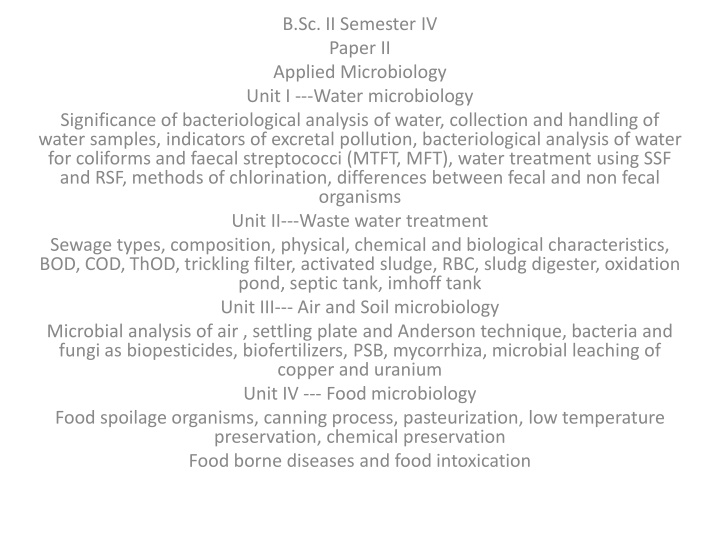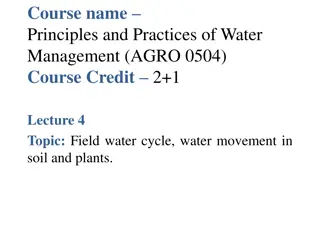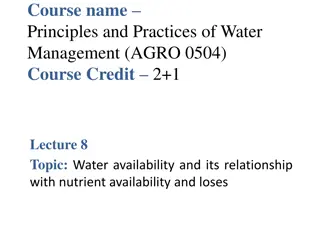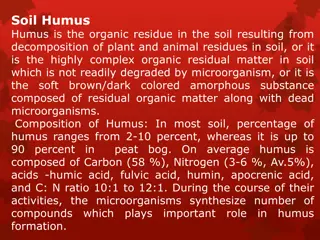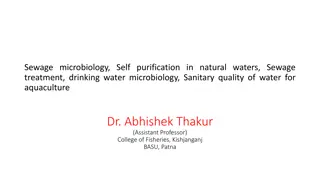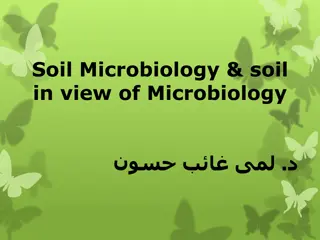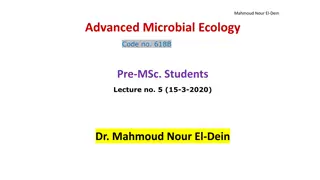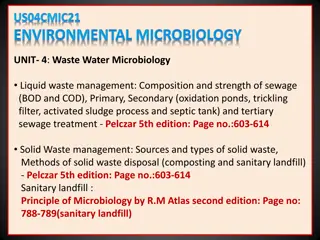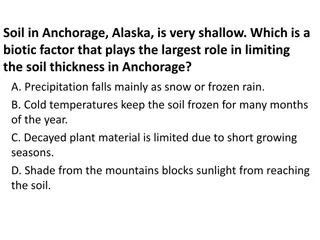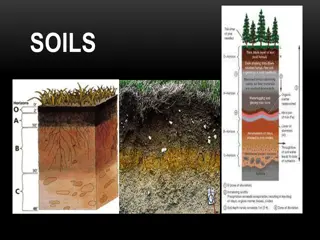Applied Microbiology in Water, Waste, Air, Soil, and Food
Exploring the significance of bacteriological analysis in water and wastewater, air and soil microbiology, and food microbiology. Topics include indicators of pollution, water treatment methods, wastewater treatment processes, microbial analysis techniques for air and soil, and food preservation techniques.
Download Presentation

Please find below an Image/Link to download the presentation.
The content on the website is provided AS IS for your information and personal use only. It may not be sold, licensed, or shared on other websites without obtaining consent from the author.If you encounter any issues during the download, it is possible that the publisher has removed the file from their server.
You are allowed to download the files provided on this website for personal or commercial use, subject to the condition that they are used lawfully. All files are the property of their respective owners.
The content on the website is provided AS IS for your information and personal use only. It may not be sold, licensed, or shared on other websites without obtaining consent from the author.
E N D
Presentation Transcript
B.Sc. II Semester IV Paper II Applied Microbiology Unit I ---Water microbiology Significance of bacteriological analysis of water, collection and handling of water samples, indicators of excretal pollution, bacteriological analysis of water for coliforms and faecal streptococci (MTFT, MFT), water treatment using SSF and RSF, methods of chlorination, differences between fecal and non fecal organisms Unit II---Waste water treatment Sewage types, composition, physical, chemical and biological characteristics, BOD, COD, ThOD, trickling filter, activated sludge, RBC, sludg digester, oxidation pond, septic tank, imhoff tank Unit III--- Air and Soil microbiology Microbial analysis of air , settling plate and Anderson technique, bacteria and fungi as biopesticides, biofertilizers, PSB, mycorrhiza, microbial leaching of copper and uranium Unit IV --- Food microbiology Food spoilage organisms, canning process, pasteurization, low temperature preservation, chemical preservation Food borne diseases and food intoxication
Coliforms The coliform group includes E. coli, Enterobacter aerogenes, and Klebsiella pneumoniae. Coliforms are defined as facultatively anaerobic, gram-negative, nonsporing, rod-shaped bacteria that ferment lactose with gas formation within 48 hours at 37 C.
Bacteriological Analysis of Water (Tests for Coliforms) Multiple Tube Fermentation Technique Or Multiple Tube Dilution Technique Or MPN Technique (If only first test is performed )
Membrane Filtration Technique Alternative to MPN or MTFT use by government labs for monitoring drinking water, used for microbial monitoring in the pharmaceutical, cosmetics, electronics, and food and beverage industries Less time required
Membrane Filter Made of cellulose acetate or Nylon,6,6. 0.45 micro m 47 mm in diameter
Total coliform /100 ml = coliform colonies counted X 100/ ml of sample filtered
Tests for faecal Streptococci Streptococcus faecalis Streptococcus bovis Persist for longer than coliform Resistant to drying
MTFT for Faecal Streptococci Presumptive Test 15 test tubes with Azide Dextrose broth Incubate at 370C for 24 - 48hrs Test for turbidity Confirmed Test All positive presumptive tubes are streaked on Esculin Azide Agar or Pfizer Selective Enterococcus Agar Incubate at 370C for 24hrs Brownish black colonies with brown halos Refer to MPN for result
MFT for Faecal streptococci K-Streptococcus or M-Enterococcus agar Dark red to pink colonies Slanitz & Barley s Medium Red or maroon colonies
